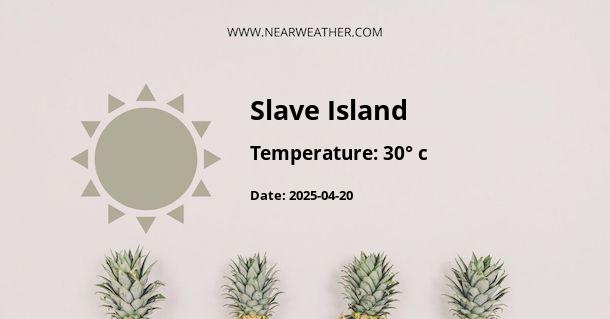Weather
26° 
Climate Conditions: overcast clouds
Humidity: 87%
Wind speed: 20.23 km/h
Wind direction: 253°
Daily Weather Forecast
Monday
08/04/2025
Climate Conditions: light rain
Humidity: 87%
Tuesday
08/05/2025
Climate Conditions: light rain
Humidity: 85%
Wednesday
08/06/2025
Climate Conditions: light rain
Humidity: 84%
Thursday
08/07/2025
Climate Conditions: light rain
Humidity: 85%
Friday
08/08/2025
Climate Conditions: light rain
Humidity: 86%
Evolution
Daily Weather Forecast Evolution (°C)
Lowest temperature
Highest temperature
Other Information
Sunrise
06:04
Sunset
18:28
Latitude
6.916670
Longitude
79.849998
Timezone: GMT+05:30
More about Slave Island:
Climate and Weather in Slave Island, Sri Lanka
Slave Island, also known as Colombo 02, is a vibrant neighborhood situated in the heart of Colombo, the capital city of Sri Lanka. As a tropical destination, Slave Island experiences a warm and humid climate throughout the year. In this article, we will explore the weather patterns and climatic conditions in Slave Island, providing detailed information on temperature, rainfall, and other relevant aspects.Temperature
Slave Island enjoys a consistently warm climate, with relatively high temperatures year-round. The average daily temperature hovers around 27 degrees Celsius (80.6 degrees Fahrenheit), making it an ideal destination for those who enjoy warm weather. The temperature rarely drops below 25 degrees Celsius (77 degrees Fahrenheit) even during the cooler months. During the hottest months of the year, from April to July, temperatures can reach as high as 31 degrees Celsius (87.8 degrees Fahrenheit) during the daytime. However, a refreshing sea breeze often provides relief from the heat in coastal areas like Slave Island.Rainfall
Like many other regions in Sri Lanka, Slave Island experiences two distinct monsoon seasons that contribute to the overall annual rainfall. The southwest monsoon, known as the Yala monsoon, occurs from May to September, while the northeast monsoon, known as the Maha monsoon, takes place from November to February. The Yala monsoon brings the heaviest rainfall to the region, with an average monthly precipitation of around 300 to 400 millimeters (11.8 to 15.7 inches). This period is characterized by frequent showers and occasional thunderstorms. The Maha monsoon, on the other hand, brings relatively less rainfall, with an average monthly precipitation of around 100 to 200 millimeters (3.9 to 7.9 inches). The months of October and March serve as transition periods between the two monsoons, with rainfall gradually decreasing or increasing, respectively. It is worth noting that even during the monsoon seasons, rainfall in Slave Island is usually in the form of short-duration heavy showers, interspersed with sunny intervals.Humidity
Being located in a tropical region, Slave Island experiences high humidity levels throughout the year. The average relative humidity ranges from 70% to 90% during the wet season and around 60% to 80% during the dry season. The combination of high temperatures and humidity can make the weather feel hotter than the actual temperature, especially during the summer months.Seasonal Variations
While Slave Island generally has a warm and humid climate, there are some variations in weather patterns throughout the year. Here is a breakdown of the typical weather conditions during each season: Summer (March to June): During the summer months, temperatures are at their peak, reaching highs of around 31 degrees Celsius (87.8 degrees Fahrenheit). The humidity is relatively high, and occasional thunderstorms are common in the afternoon or evening. Monsoon Season (May to September): This period experiences the highest rainfall, particularly during the Yala monsoon. Heavy showers are frequent, and the weather can be unpredictable. It is advisable to carry an umbrella or raincoat when venturing out. Transition Periods (October and March): These months are characterized by changing weather conditions as the monsoon transitions. Rainfall gradually decreases or increases, and temperatures start to cool down slightly. Winter (November to February): The winter months in Slave Island are relatively cooler compared to the rest of the year, with temperatures ranging from 25 to 28 degrees Celsius (77 to 82.4 degrees Fahrenheit). The Maha monsoon brings some rainfall, but it is generally less intense than during the Yala monsoon.Best Time to Visit
The best time to visit Slave Island and explore the city of Colombo is during the winter months (November to February). During this period, the weather is pleasant, with milder temperatures and lower humidity levels. The chances of rainfall are relatively lower, allowing for more outdoor activities and sightseeing. It is important to note that despite the weather conditions, Slave Island offers a range of attractions and activities year-round. Whether you visit during the hot summer months or the rainy monsoon season, you can still enjoy the vibrant culture, historical landmarks, and delicious cuisine that the neighborhood and Colombo have to offer. In conclusion, Slave Island, Sri Lanka, experiences a tropical climate with warm temperatures and high humidity throughout the year. The monsoon seasons bring significant rainfall, with the Yala monsoon from May to September being the wettest period. The winter months offer milder temperatures and lower chances of rainfall, making it an ideal time to visit. Regardless of the season, Slave Island and Colombo have a lot to offer in terms of cultural experiences and attractions.FAQ's about Slave Island's Weather:
Q - What is the Latitude and Longitude of Slave Island?
A - Slave Island's Latitude is 6.916670 & Longitude is 79.849998.
Q - What is the weather in Slave Island today?
A - Weather in Slave Island is 26° today.
Q - What is the climatic condition of Slave Island today?
A - Climate Conditions in Slave Island shows overcast clouds today.
Q - What is the humidity in Slave Island today?
A - Humidity in Slave Island is 87% today.
Q - What is the wind speed in Slave Island today?
A - Wind speed in Slave Island is 20.23 km/h, flowing at 253° wind direction. today.

Nearby Locations
Latest searched locations